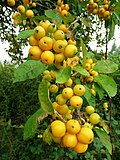You can help expand this article with text translated from the corresponding article in Japanese. (September 2025)Click [show] for important translation instructions.
|
| Malus asiatica | |
|---|---|
 | |
| Scientific classification | |
| Kingdom: | Plantae |
| Clade: | Tracheophytes |
| Clade: | Angiosperms |
| Clade: | Eudicots |
| Clade: | Rosids |
| Order: | Rosales |
| Family: | Rosaceae |
| Genus: | Malus |
| Species: | M. asiatica |
| Binomial name | |
| Malus asiatica | |
Malus asiatica also known as neunggeum apple [1] or Chinese pearleaf crabapple is a species in the genus Malus , in the family Rosaceae. [2] It is native to China and Korea. [3] [4]

